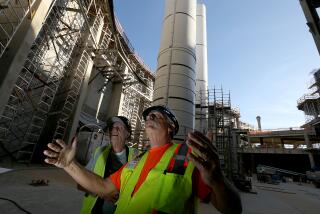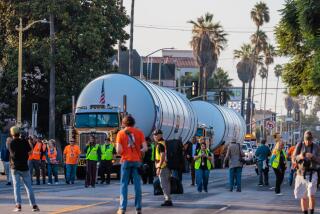King-Size Capsules : Powers Design Completes Its Work on Space Station Modules
- Share via
NEWPORT BEACH — On a quiet street in West Newport on Monday, two huge white capsules lay on their sides like something from a science fiction movie.
The two modules, 43 feet long and more than 14 feet wide, are full-size mock-ups of the living quarters and scientific laboratory for the manned space station Freedom, which NASA hopes to have operational by the year 1999.
The space station mock-ups were designed and built by Powers Design International, 828 Production Place, for McDonnell Douglas, one of four companies that have been awarded work packages for the space station. The other companies--Boeing Aerospace, Rocketdyne and General Electric--will be building similar mock-ups of various parts of the space station to be used in their design and manufacturing work.
The $16-billion space station would orbit Earth at 1,700 m.p.h., more than 100 miles up.
On Monday, as the final touches were being put on the structures in a parking lot at Powers Design, company President Robert Powers said his small team of designers, along with engineers from McDonnell Douglas, has been working 12- and 14-hour days, seven days a week, to meet the contract deadline.
Lining the inner walls of the capsules are stenciled patterns of computer screens and drawers, soon to be covered with yellow stick-up notes from engineers and designers with ideas for the real modules. Every inch of space around the walls, ceiling and floors will be used for hatches and compartments for the eight people who will inhabit the station.
The modules were to be loaded onto trucks Monday evening and taken to McDonnell Douglas’ Huntington Beach facility, where they will be reviewed by McDonnell Douglas and NASA engineers, and where the public will have an opportunity to walk through them. The mock-ups are used by engineers who determine how the computer, power and operational systems should be arranged for the space station.
The final modules, which will be just long enough to fit inside the cargo bay of the space shuttle, will weigh nearly 70,000 pounds each, and will be assembled in space.
The first pieces for assembly of the space station are due to be launched in 1995. The station will be used to determine the long-term effects of living with zero gravity.
More to Read
Sign up for Essential California
The most important California stories and recommendations in your inbox every morning.
You may occasionally receive promotional content from the Los Angeles Times.










